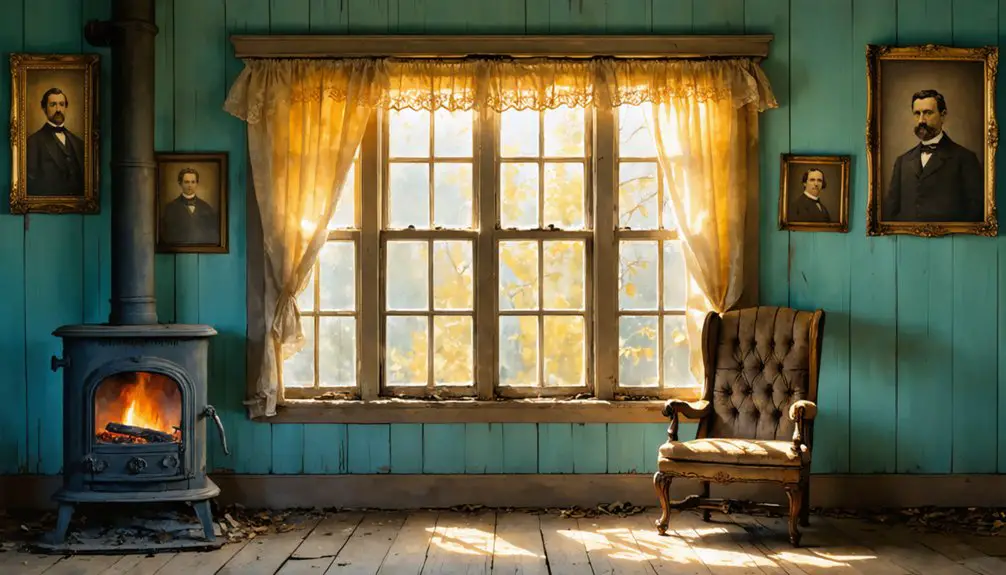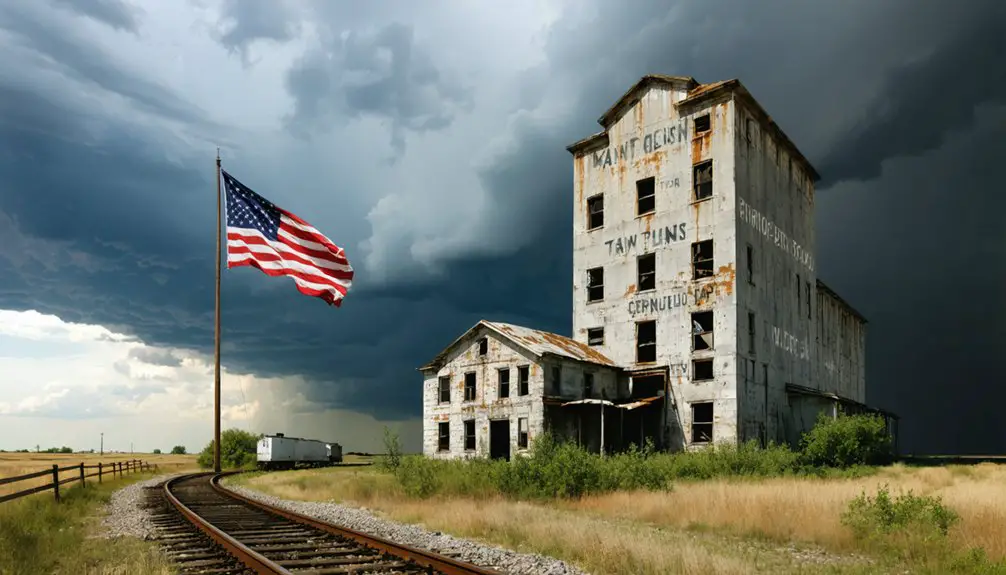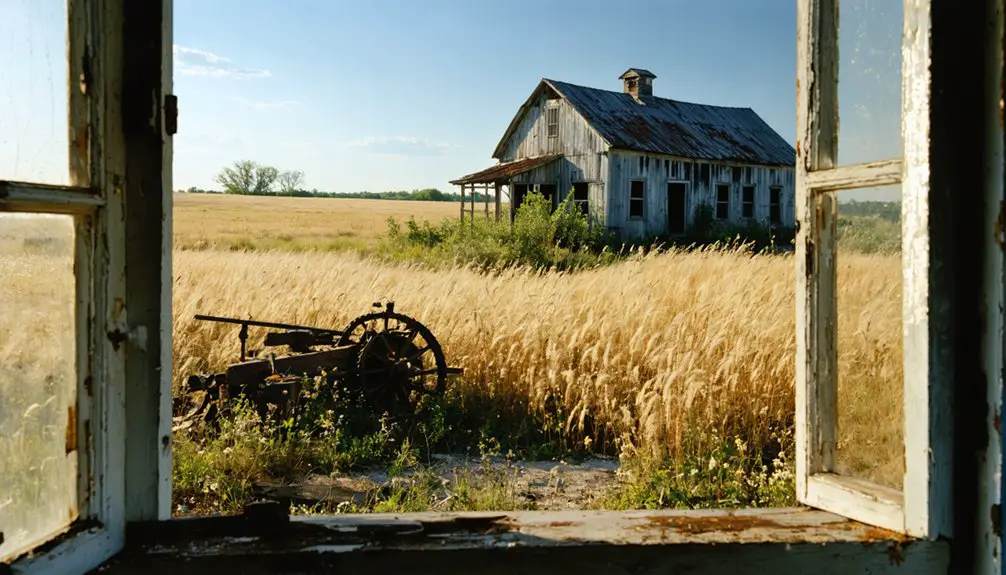You’ll discover Superior, Kansas along historic Dragoon Creek, where pioneer settlers built their first cabins in the late 1850s. The settlement quickly grew into Weller County’s first county seat, nearly becoming Kansas’s state capital in 1859. While the arrival of the Burlington Northern Railroad in 1880 brought temporary prosperity with five rail lines by the 1940s, Superior’s decline has left behind fascinating remnants of its frontier ambitions.
Key Takeaways
- Superior, Kansas was established in 1859 as the first county seat of Weller County and nearly became the state capital.
- The town featured a steam mill, Presbyterian Church, post office, and approximately 30 residential dwellings during its peak.
- The Burlington Northern Railroad’s arrival in 1880 temporarily revived the economy, with five railroads serving Superior by the 1940s.
- Despite early promise and infrastructure development, Superior gradually transformed into an abandoned settlement following economic challenges.
- The town’s foundation along Dragoon Creek supported early settlers but couldn’t sustain long-term growth and population retention.
The Birth of a Pioneer Settlement
When pioneers first ventured into what would become Superior, Kansas, in the late 1850s, they found promising land along Dragoon Creek that beckoned settlement.
Abel Polley, William Tillinghast, Abram Leonard, and E.O. Perin staked their claims in this fertile region, with Leonard and Perin constructing the first cabins that would anchor the future townsite.
These brave pioneers laid Superior’s cornerstone, with Leonard and Perin building the first humble dwellings in this promising land.
You’ll find their story embedded in what was then Weller County, later renamed Osage County in 1859.
Despite pioneer hardships and the challenges of early agriculture, these determined settlers recognized the area’s potential.
The abundant water sources proved critical for farming and community growth.
Their vision soon attracted James M. Winchell, who’d survey the 640-acre townsite and promote Superior as a potential state capital.
Similar to Superior, Nebraska’s early development, the town’s Victorian charm would become a defining feature of its architecture.
The community quickly established a steam saw and grist mill to support local industry and agriculture.
Early Days as County Seat
As Superior gained prominence in the newly formed Weller County, the town quickly established itself as the first county seat in 1859. Early governance centered around the Superior Hotel, which served multiple roles in the growing community. Similar to Santa Fe Trail towns of later decades, Superior’s strategic location helped drive its early success.
Under James Winchell’s leadership, the town’s ambitions extended beyond local politics – Superior nearly became Kansas’ capital city, losing to Topeka by just two votes.
Key elements of community growth included:
- Steam-powered saw and grist mill operations
- Presbyterian Church establishment
- Multiple stores and shops
- Post office opening on March 4, 1859
- Approximately 30 residential dwellings
You’ll find it fascinating that Superior’s political influence peaked during the Wyandotte Constitutional Convention, where Winchell served as president, helping shape Kansas’ state constitution that’s still in effect today.
The town’s promising start, however, would soon face unexpected challenges. Like the fate of Fargo Springs, the town would eventually be abandoned after being bypassed by crucial railroad development.
Life Along Dragoon Creek
You’ll find early Superior settlers strategically positioned themselves along Dragoon Creek to guarantee reliable water access for their homesteads and livestock.
The creek’s steady flow supported the town’s growth through the 1850s, enabling the construction of a steam-powered saw and grist mill that became central to the community’s development. During this period, the area gained its name from the Second Dragoons who patrolled the region.
Residents gathered along the creek’s banks for social activities, including church meetings in nearby log cabins and trading with neighboring settlements. The Dragoon Creek settlement demonstrated remarkable patriotism during the Civil War, with 37 men serving in various military units between 1861-1869.
Early Settler Water Access
The twelve pioneer families who settled along Dragoon Creek by fall 1857 strategically positioned their homesteads to maximize water access from this essential waterway.
You’ll find their water sustainability practices centered around the creek’s natural features, including springs and seeps that enhanced their ability to collect water for daily needs. James Winchell first surveyed this vital waterway to support the Superior settlement’s development.
Early settlers relied heavily on George Harvey’s spring for their water needs until they could successfully dig their own wells.
The creek’s importance to settler survival can’t be overstated, as demonstrated by these critical water uses:
- Household water collection from primitive wells
- Livestock watering areas along riparian zones
- Agricultural irrigation for crop cultivation
- Natural lowland water retention for soil moisture
- Strategic water gathering points near stone walls
The creek’s 30-foot valley incision created ideal conditions for water collection, while the dendritic stream system guaranteed creek ecology remained viable for the growing settlement’s needs.
Creek-Based Town Development
While pioneers initially settled along Dragoon Creek for its water resources, they soon established a vibrant township centered around Superior’s growing infrastructure.
You’d have found steam-powered mills harnessing the creek’s flow, while pioneer agriculture flourished along its fertile banks. The 640-acre townsite emerged strategically near the creek, where you’d spot about 30 dwellings, including the Superior Hotel that served multiple community functions.
The creek ecology shaped the town’s development, as settlers built bridges and roads connecting Superior to Centropolis and Allen. Local shops and stores sprouted up to service both residents and travelers, creating a hub of commerce. The first commissioners’ meeting was held here in 1859, establishing Superior’s early importance in county governance. The settlers formed protective associations to guard against potential tribal conflicts during the town’s early development.
The creek-based settlement pattern reflected the practical needs of frontier life, where water access determined a town’s success.
Riverside Community Activities
Life along Dragoon Creek thrived through vibrant social organizations and civic groups that shaped Superior’s community fabric. You’d find community engagement centered around organizations like the NAACP, established in 1942, which championed social justice and equality. Local leaders including Stratton, Boykin, and Hopkin drove these initiatives forward.
The heart of community life revolved around these key institutions:
- Presbyterian Church services, initially held in log cabins
- Superior Hotel, serving multiple roles as courthouse and gathering space
- Local schools doubling as social and communal hubs
- Entrepreneurial ventures including stores and cafes
- Religious institutions fostering social cohesion
Education remained central to community advancement, with new schools funded by the 1909 bond supporting both academic and social growth.
These institutions created lasting networks that strengthened Superior’s social fabric.
Notable Founding Families

Among Superior’s most influential early settlers, you’ll find Abel Polley staking the first land claim along Dragoon Creek in what would become the town’s northern quarter.
E.O. Perin and Abram Leonard quickly followed by constructing the settlement’s first permanent cabins, establishing themselves as cornerstone families of the frontier community.
These founding families worked alongside James M. Winchell’s leadership to transform Superior from a collection of scattered claims into an organized township that nearly became Kansas’s state capital.
Early Settler Leadership Roles
The pioneering leadership of Superior, Kansas emerged from a core group of determined settlers who claimed land along Dragoon Creek in the late 1850s. Under James M. Winchell’s settler governance, the town rapidly developed from wilderness into an organized community.
The Town Company’s strategic vision established Superior as a formidable settlement, nearly becoming Kansas’s capital.
Key figures who shaped Superior’s early development included:
- James Winchell – Town surveyor and constitutional convention president
- Reverend Alonzo Shurtleff – Spiritual leader and town incorporator
- Professor Daniels – Wisconsin State Geologist and town planner
- Abel Polley – Original land claimant
- E.O. Perin – Early cabin builder and settler
Through community organization, these leaders established essential infrastructure including mills, roads, and the Superior Hotel, which served multiple civic functions as courthouse, school, and church.
Polley Family Land Claims
Prominent among Superior’s founding settlers, Abel Polley and his family established significant land claims along Dragoon Creek in the late 1850s, expanding upon the leadership framework set by James Winchell.
Through homesteading and strategic purchases, the Polley family secured extensive agricultural holdings that would shape Superior’s early development.
You’ll find that their land acquisition wasn’t without challenges. Like many settlers of that era, the Polley family navigated complex government policies and occasional land disputes while establishing their presence in the region.
They adapted their farming practices to the Kansas climate, introducing innovative agricultural techniques that influenced neighboring settlers.
Their perseverance in maintaining these claims, despite the inherent challenges of frontier life, helped establish Superior as a viable agricultural community in its early years.
Perin’s Territorial Influence
While James Winchell would later emerge as Superior’s most prominent leader, E.O. Perin‘s contributions proved foundational to Superior’s early development. Along with Abram Leonard, Perin established one of the first cabins on Dragoon Creek, setting the stage for territorial claims that would shape the future town.
Perin’s influence extended beyond his initial settlement, as his strategic land claim helped enable:
- Construction of essential community buildings
- Development of the town’s first bridge
- Establishment of crucial transportation routes
- Creation of a diverse economic base
- Formation of partnerships with the Town Company
You’ll find Perin’s territorial influence woven throughout Superior’s early success story, from supporting the Presbyterian Church’s construction to helping establish the Superior Hotel, which served multiple functions as courthouse and school.
His pioneering spirit helped position Superior to nearly become Kansas’ capital city.
Political Power Struggles

Throughout Kansas’s territorial period, Superior found itself embroiled in fierce political battles that shaped its destiny.
You’ll find that Superior came remarkably close to becoming Kansas’s capital city, losing by just two votes in a contentious election marked by political corruption and manipulation. The town’s fate was deeply intertwined with the broader struggles between pro-slavery and free-state factions that dominated territorial politics.
Under the leadership of James Winchell, who’d later become president of the Wyandotte Constitutional Convention, Superior gained significant political influence.
However, like many ambitious Kansas towns, it faced fierce competition from rival communities vying for political supremacy. The town’s political aspirations were ultimately thwarted by the same forces of election manipulation and speculative schemes that plagued other territorial settlements.
The Railroad’s Fateful Impact
The arrival of the Burlington Northern Railroad in 1880 marked a defining moment in Superior’s trajectory, forever altering its economic landscape.
You’ll find that this railroad influence sparked an unprecedented economic revival, transforming Superior into a bustling hub served by five railroads by the 1940s.
The railroad’s impact brought:
- New grain elevators and manufacturing plants
- A thriving hydroelectric facility
- A prosperous cheese plant
- A successful bottling operation
- Peak population growth reaching 3,200 residents
Yet freedom from rail dependency proved costly for neighboring Santa Fe when the main line bypassed their town for Sublette instead.
You can trace Santa Fe’s slow decline directly to this fateful routing decision, while Superior’s strategic rail position continued fueling its growth until broader transportation shifts diminished rail’s dominance across Kansas.
From Bustling Hub to Abandonment

Despite its promising beginnings as Osage County’s first seat in 1859, Superior’s fortunes took a devastating turn when a powerful tornado struck that same year, destroying most of the town’s infrastructure.
While the community’s resilience was evident in their initial response to rebuild, the catastrophic damage had already set a pattern of decline that would prove difficult to overcome.
You’ll find that Superior’s economic challenges multiplied as neighboring towns discovered richer coal deposits, drawing away workers and businesses.
The town’s population steadily decreased as schools closed and residents sought opportunities elsewhere.
What was once a vibrant hub that nearly became Kansas’ state capital gradually transformed into an abandoned settlement.
Today, you’ll see only scattered remnants and foundations where Superior’s buildings once stood, marking the site of this ambitious frontier town.
Legacy in Kansas Settlement History
While Superior’s physical structures have largely vanished, its pioneering spirit and historical significance remain deeply woven into Kansas’s settlement narrative.
You’ll find Superior’s story exemplifies the remarkable pioneer collaboration that shaped early Kansas towns, as settlers and entrepreneurs worked together in civic development.
- The town’s multi-use buildings showcased frontier resourcefulness
- Superior nearly became Kansas’s state capital, losing to Topeka by two votes
- James M. Winchell’s leadership in the Wyandotte Constitutional Convention
- The establishment of essential infrastructure like mills and bridges
- Creation of key transportation routes connecting regional communities
This ghost town’s legacy teaches you about the determination of early Kansans, their adaptive spirit, and their role in establishing the governmental framework that still guides the state today.
Frequently Asked Questions
What Was the Peak Population of Superior During Its Most Prosperous Years?
Based on historical population trends and ghost town demographics of similar Kansas railroad towns, you’ll find Superior’s peak population likely reached between 400-800 residents during its most prosperous late 1800s period.
Were There Any Significant Natural Disasters That Contributed to Superior’s Decline?
An 1859 tornado obliterated nearly 100% of the town, devastating early settlement efforts. You’ll find this natural disaster, combined with recurring regional droughts in the 1880s-1890s, accelerated Superior’s economic decline.
What Businesses and Industries Operated in Superior Before Its Abandonment?
You’d have found bustling agricultural practices centered around a steam sawmill and grist mill, while local businesses included a prominent hotel, post office, stores, and shops serving the surrounding farming community.
Did Any Notable Historical Figures Ever Visit or Stay in Superior?
As hard as you might dig, there’s no evidence showing any famous visitors to Superior. Historical accounts focus on local founders like James Winchell rather than nationally notable figures spending time there.
What Happened to the Cemetery and Burial Grounds of Superior’s Residents?
You won’t find complete burial records or cemetery restoration efforts, as the burial grounds likely fell into disrepair after the 1859 tornado. Most graves are probably unmarked now in overgrown fields.
References
- https://www.quincyvagell.com/2019/09/25/ravanna/
- https://www.youtube.com/watch?v=Pf5n1PX1g3M
- https://legendsofkansas.com/superior-kansas/
- https://www.youtube.com/watch?v=xCbFN_yLFrk
- https://fhsuguides.fhsu.edu/kansasheritage/sewardcounty
- https://www.bankfmb.com/love-my-community-superior/
- https://legendsofkansas.com/kansas-settlers/
- https://swissmennonite.org/wp-content/uploads/2018/11/Pioneer-Life-and-Lore-of-McPherson-County-Kansas-Wayne-digitized-072617.pdf
- https://en.wikipedia.org/wiki/History_of_Kansas
- https://digging-history.com/2015/02/18/ghost-town-wednesday-santa-fe-kansas/



